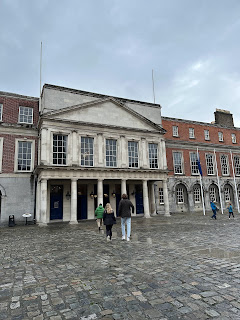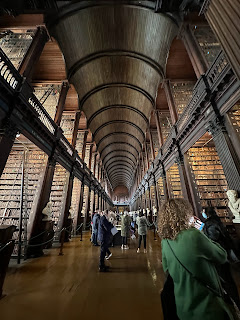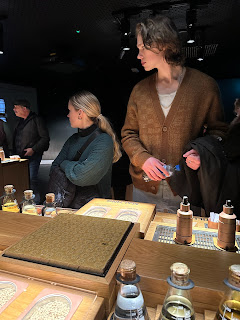Our hotel has a theme of music that runs from the lobby through the elevators and into the rooms. Lyrics line the walls in tasteful handwriting. It gives the place a very welcoming, creative vibe.
On our second morning in Dublin, we set off around brunch time for the other breakfast place recommended by our hotel,
Lemon Jelly. We beat the line by a few minutes and filled up on yummy omelets, Irish breakfasts, and Americanos. It was history day in every possible way: on the schedule were the Dublin Castle, Book of Kells, Jameson Distillery, and a ghost bus. Plus some food in between.
Our walk to the castle on this grey day took us past murals and lovely architectural elements. Dublin is a compact city, easy to walk with something to grab your eye around every corner. It's Ireland's largest, but even so, it has only about a half a million residents, a bit more than two-thirds the size of DC. There is great concern about the cost of living in Dublin, but according to international rankings, it's still less expensive to live there than in cities like NYC, DC, Miami, Seattle, and more. Our meals and purchases were basically the same cost as if we had gone out to dinner and shopping in the DMV.
Next stop Dublin Castle, or as a visiting Queen Victoria apparently observed, a place that was very much like a castle. Take that, Irish.
To be honest, it was a bit smaller than other castles we've seen, but Ireland is smaller, too. So, let's just say it's proportional. And, quite lovely! As overcast and misty as it was outside, it was bright and sparkling on the inside, and it was newly decorated for the holiday. (Objects in photo may appear taller due to leprechauns.)
The most popular holiday market in Ireland is at the Castle, and I read up before arriving that: 1) it doesn't start til mid-December; 2) all the tickets were gone within an hour, leading to a huge controversy. We were fine with the trees. I made Harper and Penn stop at each tree to get their picture taken for a possible holiday card photo. You can tell how absolutely thrilled they were--and the excitement only grew at each tree we encountered!
Our two favorite features of the red room, beyond it's gorgeousness, were the creepy doll collection and watching the curators work. As Harper observed, "it's so cool, they really work here!"
As someone who's a quarter Irish, I don't know as much about Ireland as I should, I suppose--though I should get credit for rereading Dubliners on the plane. Anyway, one thing I learned at the Castle was that the Irish flag represents the green of Ireland, the Orange of English, and the white for the peace between the two.
I can only imagine that this chandelier weighs as much as my car. It's always astonishing to see the wealth behind royal walls and recall the poverty outside them. Beauty has a price. Today, the Castle hosts EU events and other gatherings in its huge ballroom. Imagine the swirling social scene when it was the seat of British rule and how anarchic it must have been to have the Irish republic crash the gates in 1922. Our two are keeping watch, just in case ...
Look, so happy to be photographed!
Shot, reverse shot thanks to the many royal mirrors!
Our next stop: Trinity College, home to the Book of Kells. The university is right in the center of Dublin at a fairly busy intersection that was likely just as busy--but in a different way--when it was founded in 1592.
As we walked in with many other tourists, I wondered what it must feel like to study in one of your town's primary tourist attractions. UF likely drew tourists in Gainesville, but very few if any of them came in search of the library.
Photos are not allowed in the
Book of Kells exhibit--which features, at its very end, one double leaf from the book itself. Most of the tour is a walk through of images of the pages with explanations of their illuminations, 9th century context setting for the book, and details of the making of the book itself. We learned that the monks often wrote notes in the margins, such as "this is taking too long" and "I wish this was done"; that when the book was rebound in the 1800s, the bookbinder just cut off some of the illuminated margins to make it fit (seriously); and that it took about 185 calf hides to make the book. These were "cured" in feces, which helped soften the hides and remove the fur; then scraped clean, a process which left visible holes in some of the pages that the monks just worked around. When we finally walked into the very dark room to see the two pages, it really did feel magical--as perfectly captured by the Borges quote stenciled on the wall: "I have always imagined that Paradise will be a kind of library."
From there, you ascend a staircase into a library that would have fulfilled Borges's vision: the aptly named Long Room. A working library since 1792, it houses ancient books in a barrel-ceilinged cathedral to learning.
The room smells like warm, chocolatey, woodsy knowledge. Each side is lined with busts of famous and not-so-famous writers and scholars (see Shakespeare and Milton, below). Although women have been admitted to Trinity since 1910, there had been no women among the busts. Trinity recently took a vote and four women, including Ada Lovelace, will be added. Still, it's amazing!!
Among the library's holdings is one of the very few remaining copies of the declaration of the provisional government of the Irish Republic--kind of like having a copy of the Declaration of Independence at your college.
The symbol of Ireland is the harp, and over the years, it came to stand for Irish independence, as the instrument's popularity long pre-dated British occupation. The library has the country's oldest medieval harp, dating to the 14th century. This harp is said to be the model for the Guinness harp (more on that later).
Filled with history, it was time to fill ourselves with yummy and absolutely gluten-free fish and chips from
Beshoff Brothers. Harper remarked several times how easy it was to be gf in Ireland. All menus are very clearly marked with allergens, and there's a real effort to be "coeliac" friendly at many restaurants. Well done, Ireland!
On our way back to the hotel to drop some purchases, we grabbed a caffeine pick-me-up at the cute Panem bakery (decidedly gluten-filled) around the corner because we still had several stops that day!
The first was the Jameson Whiskey Distillery. While the spirits are now actually distilled a bit down the road in County Cork, the Distillery has been a fixture in Dublin since the 1700s, playing a role in everything from supporting families during the famine (or hunger, more on that later) to the 1922 war for independence, when Republican soldiers holed up in the Distillery. Today, it's got a great rustic chic vibe with very friendly staff and many, many green Jameson bottles.
Our tour included a tasting (drinking age in Ireland is 18), and Harper was very pleasantly surprised to learn that Jameson Whiskey is "coeliac" friendly. The guide implored her to "tell all your friends the good news!"
Although no where near us on this trip, Mango and Rhubarb somehow managed to buy Ned a limited edition bottle of Jameson available only at the factory and get it engraved with their names. Clever dogs--happy Ned!
We stopped off once more at the Morrison and then ran back across the River Liffey, this time to grab delicious burgers (with gf buns as needed) and (gf) fries before quick walking it back to Trinity College to catch our ghost bus.
I had booked this tour because of its ratings and its (purported) focus on stories related to the Irish Famine. We learned that many refer to the "famine" as the "hunger," because there was no shortage of food--rather the British were shipping Irish produce and goods back to England, leaving none for those in Ireland.
The double decker bus was converted to have a spooky, haunted house-like chamber on the first floor and seats and a stage on the second. We were the last to arrive, and because it was so dark, we didn't know how many people were on the bus until our first stop. Turns out, it was fairly crowded.


Also turns out that this ghost tour didn't really focus on the deaths of the famine. It was more the story of two struggling acting students in Dublin (one of whom was very clearly American) who sometimes struggled to remember the stories they were telling, sometimes seemed to very-much-for-real fall on the bus staircase, and sometimes forgot their cues. After a full day of Dublin, though, we were ready to go with the absurdity of it all, and because Penn and Harper wound up in the first row, they became part of the show. Penn hiding the skull of a ghost's wife and playing it off with aplomb when she reappeared and demanded it back, and Harper reading the Lord's Prayer note perfectly in reverse to summon more ghosts (who might have called it an early night). Both won acclaim from their fellow tourists.


There was only one way to end such an eventful and wonderful day--a night at Dublin's most famous pub: the Temple Bar. We squeezed in to the done-up-for-the-holidays and super welcoming pub just in time to sing-along to a run of ABBA songs. After a while, we all snagged seats and settled in for another set by the very-game duo playing everything from Taylor Swift to U2 to Outkast and enjoyed the cozy, gracious, and super-Irish vibe.
With our hotel just a couple blocks and a bridge away, we said our second goodnight to Dublin.


























































Comments
Post a Comment